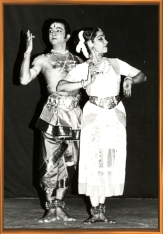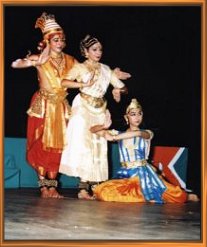

Shiva Sakthi Vel
"We wanted to bring in dance, the essence of the Shiva Parvathi concept of ardhanariswara and birth of Kartikeya. Shanmugam wrote beautiful lyrics. In the ardhanariswara segment, I performed completely in Mohanam and Shanta performed totally in Kalyani. When Shiva and Shakti merge, the ragam merged into Mohana Kalyani."
Poet Shemmanarkoil Shanmugam’s Tamizh poems on the birth of Muruga is a gripping dance drama with just three characters Shiva, Parvathi and their son Kartikeya. Music is by Reji George and T K Padmanabhan under the guidance and direction of Dhananjayan.
Sometime in 1972 or 73, someone had recommended the Dhananjayans to Shemmanarkoil Shanmugam as being receptive to using lyrics of contemporary poets for dance. He was working then in South India Shipping Corporation. He visited the Dhananjayans and after introducing himself, wrote a poem on the spot on Muruga, like a kavadi chindu. The entrance of Muruga is beautifully expressed in verse, something like the complicated lyrics ‘muthai…’ penned by Arunagirinathar.
A lot of Shaivite philosophy in Tamizh has been incorporated in Shiva Shakti Vel, generally performed in the second half of an evening’s presentation.
Production: Bharatakalanjali, Chennai.
Sometime in 1972 or 73, someone had recommended the Dhananjayans to Shemmanarkoil Shanmugam as being receptive to using lyrics of contemporary poets for dance. He was working then in South India Shipping Corporation. He visited the Dhananjayans and after introducing himself, wrote a poem on the spot on Muruga, like a kavadi chindu. The entrance of Muruga is beautifully expressed in verse, something like the complicated lyrics ‘muthai…’ penned by Arunagirinathar.
A lot of Shaivite philosophy in Tamizh has been incorporated in Shiva Shakti Vel, generally performed in the second half of an evening’s presentation.
LATEST VERSION
Choreography: The DhananjayansProduction: Bharatakalanjali, Chennai.
"We have revived one of our early Tamizh dance drama productions(1984). The uniqueness of this dance production is that it is very well within the traditional ambit, yet very contemporary in it’s outlook and presentation. The movements vocabulary, and suggestive expressions are very refreshing to both traditional and contemporary audience."
The main roles:
Shiva : SuryanarayanamurthyShakti: Anusha Natarajan
Child Murugan: Sandhya Mohan
Young Murugan: Praveen.
An exciting fight scene between Tarakasuran (T.Unnikrishnan) and Murugan is choreographed by one of our senior artist, T.Unnikrishnan. The other dancers: Sandhya Murali, Sunitha Jagadeesan, & Deepthi Vishnu Bharathi, and Pradeesh.
Scene I:
Paarvathi in a casual conversation with her Lord Shiva, enquires about the secret of creation and significance of the Nataraja Tatwam. Siva explains the purpose of His cosmic dance and the stories of moon and Ganga adorning his head.Scene II
Suddenly the cries of Devas and humans tortured by Taarakaasura reaches Paarvathi's ears. She requests Shiva to find a solution to destroy the arrogant demon. Shiva says without the help of Shakti He cannot do anything. Out of their united power emerges the great Jyothi(fire) which splits into six segments and falls into the lotuses as six babies. Mother Parvathi embraces them all to find the six-headed Shanmuga.Scene III
Muruga asks His divine parents the purpose of his birth. The Lord commands his son to destroy the Demon Taarakaasura for which they present him with Shakti Vel (a divine weapon, spear – Vel). Muruga starts on His mission.SHIVA SAKTHI VEL - Photo Album - Reviews
